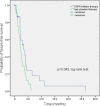Revisiting clinical trials using EGFR inhibitor-based regimens in patients with advanced non-small cell lung cancer: a retrospective analysis of an MD Anderson Cancer Center phase I population
- PMID: 23800712
- PMCID: PMC3742837
- DOI: 10.18632/oncotarget.1028
Revisiting clinical trials using EGFR inhibitor-based regimens in patients with advanced non-small cell lung cancer: a retrospective analysis of an MD Anderson Cancer Center phase I population
Abstract
Purpose: Single-agent EGFR inhibitor therapy is effective mainly in patients with lung cancer and EGFR mutations. Treating patients who develop resistance, or who are insensitive from the outset, often because of resistant mutations, other aberrations or the lack of an EGFR mutation, probably requires rational combinations. We therefore investigated the outcome of EGFR inhibitor-based combination regimens in patients with heavily-pretreated non-small cell lung cancer (NSCLC) referred to a Phase I Clinic.
Methods: We reviewed the electronic records of patients with NSCLC treated with an EGFR inhibitor-based combination regimen: erlotinib and cetuximab; erlotinib, cetuximab and bevacizumab; erlotinib and dasatinib; erlotinib and bortezomib; or cetuximab and sirolimus.
Results: EGFR mutations were detected in 16% of patients (21/131). EGFR inhibitor-based combination regimens were administered to 15 patients with EGFR-mutant NSCLC and 24 with EGFR wild-type disease. Stable disease (SD) ≥6 months/partial remission (PR) was attained in 20% of EGFR-mutant patients (3/15; two with sensitive mutations and secondary resistance to prior erlotinib, and one with a resistant mutation), as well as 26% of evaluable patients (5/19) with wild-type disease. One of three evaluable patients with squamous cell histology achieved SD for 26.5 months (EGFR wild-type, TP53-mutant, regimen=erlotinib, cetuximab and bevacizumab).
Conclusions: Eight of 34 evaluable patients (24%) with advanced, refractory NSCLC evaluable for response achieved SD ≥6 months/PR (PR=3; SD ≥6 months=5) on EGFR inhibitor-based combination regimens (erlotinib, cetuximab; erlotinib, cetuximab and bevacizumab; and, erlotinib, bortezomib), including patients with secondary resistance to single-agent EGFR inhibitors, resistant mutations, wild-type disease, and, squamous histology.
Figures



Similar articles
-
Combining erlotinib and cetuximab is associated with activity in patients with non-small cell lung cancer (including squamous cell carcinomas) and wild-type EGFR or resistant mutations.Mol Cancer Ther. 2013 Oct;12(10):2167-75. doi: 10.1158/1535-7163.MCT-12-1208. Epub 2013 Aug 20. Mol Cancer Ther. 2013. PMID: 23963360 Free PMC article. Clinical Trial.
-
Dual EGFR inhibition in combination with anti-VEGF treatment: a phase I clinical trial in non-small cell lung cancer.Oncotarget. 2013 Jan;4(1):118-27. doi: 10.18632/oncotarget.763. Oncotarget. 2013. PMID: 23435217 Free PMC article. Clinical Trial.
-
Phase II trial of dasatinib for patients with acquired resistance to treatment with the epidermal growth factor receptor tyrosine kinase inhibitors erlotinib or gefitinib.J Thorac Oncol. 2011 Jun;6(6):1128-31. doi: 10.1097/JTO.0b013e3182161508. J Thorac Oncol. 2011. PMID: 21623279 Free PMC article. Clinical Trial.
-
Inhibition of the epidermal growth factor receptor in combined modality treatment for locally advanced non-small cell lung cancer.Semin Oncol. 2005 Apr;32(2 Suppl 3):S35-41. doi: 10.1053/j.seminoncol.2005.03.008. Semin Oncol. 2005. PMID: 16015534 Review.
-
Epidermal growth factor receptor (EGFR) targeted therapies in non-small cell lung cancer (NSCLC).Rev Recent Clin Trials. 2006 Jan;1(1):1-13. doi: 10.2174/157488706775246157. Rev Recent Clin Trials. 2006. PMID: 18393776 Review.
Cited by
-
Cyclin-dependent kinase pathway aberrations in diverse malignancies: clinical and molecular characteristics.Cell Cycle. 2015;14(8):1252-9. doi: 10.1080/15384101.2015.1014149. Cell Cycle. 2015. PMID: 25695927 Free PMC article.
-
The long non-coding RNA, GAS5, enhances gefitinib-induced cell death in innate EGFR tyrosine kinase inhibitor-resistant lung adenocarcinoma cells with wide-type EGFR via downregulation of the IGF-1R expression.J Hematol Oncol. 2015 Apr 29;8:43. doi: 10.1186/s13045-015-0140-6. J Hematol Oncol. 2015. PMID: 25925741 Free PMC article.
-
MLH1 V384D polymorphism associates with poor response to EGFR tyrosine kinase inhibitors in patients with EGFR L858R-positive lung adenocarcinoma.Oncotarget. 2015 Apr 10;6(10):8407-17. doi: 10.18632/oncotarget.3511. Oncotarget. 2015. PMID: 25823662 Free PMC article.
-
Combination therapy with anti-ErbB3 monoclonal antibodies and EGFR TKIs potently inhibits non-small cell lung cancer.Oncotarget. 2013 Aug;4(8):1253-65. doi: 10.18632/oncotarget.1141. Oncotarget. 2013. PMID: 23896512 Free PMC article.
-
Diverse EGFR Exon 20 Insertions and Co-Occurring Molecular Alterations Identified by Comprehensive Genomic Profiling of NSCLC.J Thorac Oncol. 2018 Oct;13(10):1560-1568. doi: 10.1016/j.jtho.2018.06.019. Epub 2018 Jul 5. J Thorac Oncol. 2018. PMID: 29981927 Free PMC article.
References
-
- Sharma SV, Bell DW, Settleman J, Haber DA. Epidermal growth factor receptor mutations in lung cancer. Nat Rev Cancer. 2007;7(3):169–181. - PubMed
-
- Lynch TJ, Bell DW, Sordella R, Gurubhagavatula S, Okimoto RA, Brannigan BW, Harris PL, Haserlat SM, Supko JG, Haluska FG, Louis DN, Christiani DC, Settleman J, Haber DA. Activating mutations in the epidermal growth factor receptor underlying responsiveness of non-small-cell lung cancer to gefitinib. N Engl J Med. 2004;350(21):2129–2139. - PubMed
-
- Riely GJ, Pao W, Pham D, Li AR, Rizvi N, Venkatraman ES, Zakowski MF, Kris MG, Ladanyi M, Miller VA. Clinical course of patients with non-small cell lung cancer and epidermal growth factor receptor exon 19 and exon 21 mutations treated with gefitinib or erlotinib. Clin Cancer Res. 2006;12(3 Pt 1):839–844. - PubMed
-
- Janku F, Garrido-Laguna I, Petruzelka LB, Stewart DJ, Kurzrock R. Novel therapeutic targets in non-small cell lung cancer. J Thorac Oncol. 2011;6(9):1601–1612. - PubMed
Publication types
MeSH terms
Substances
Grants and funding
LinkOut - more resources
Full Text Sources
Other Literature Sources
Medical
Research Materials
Miscellaneous

